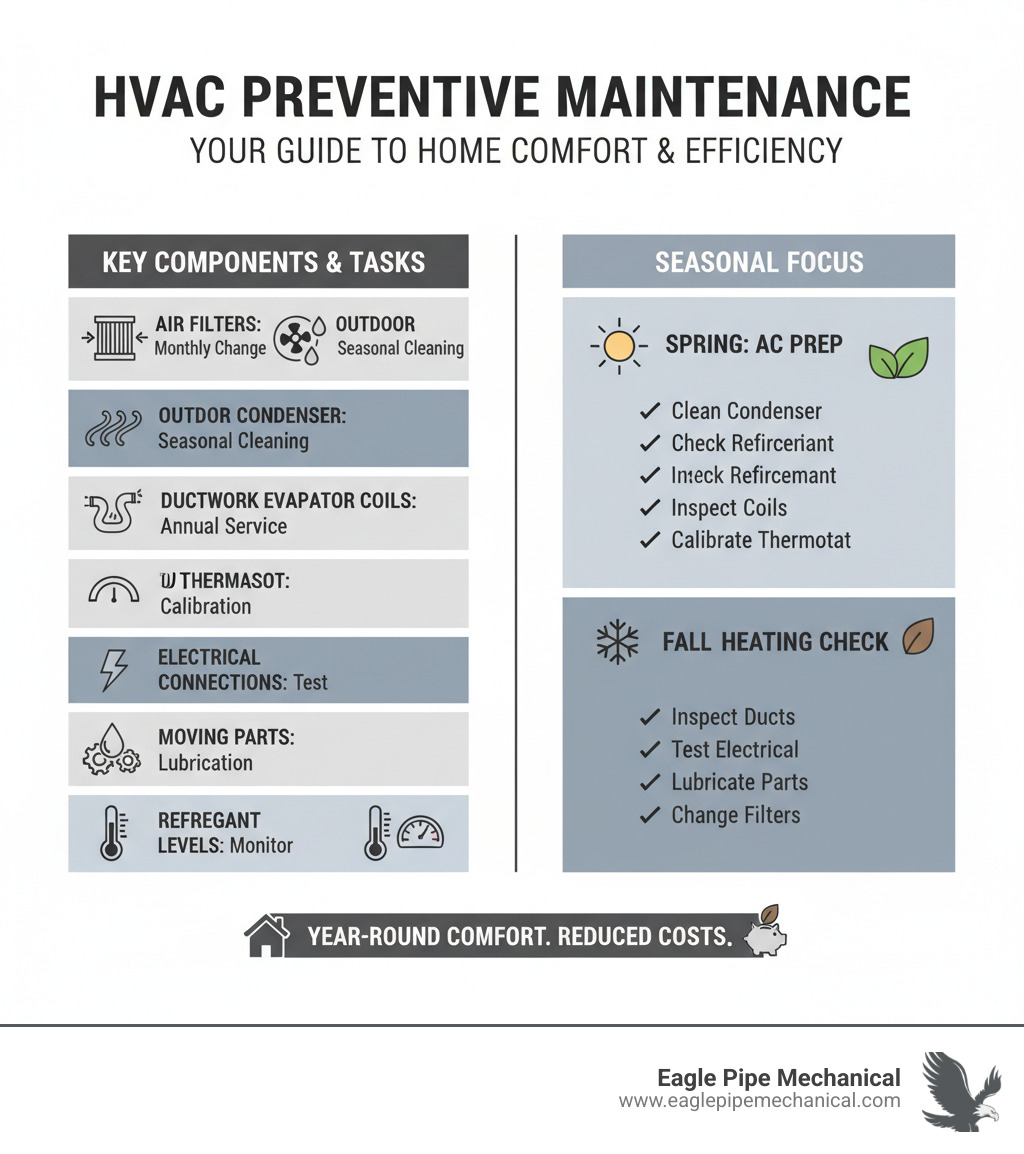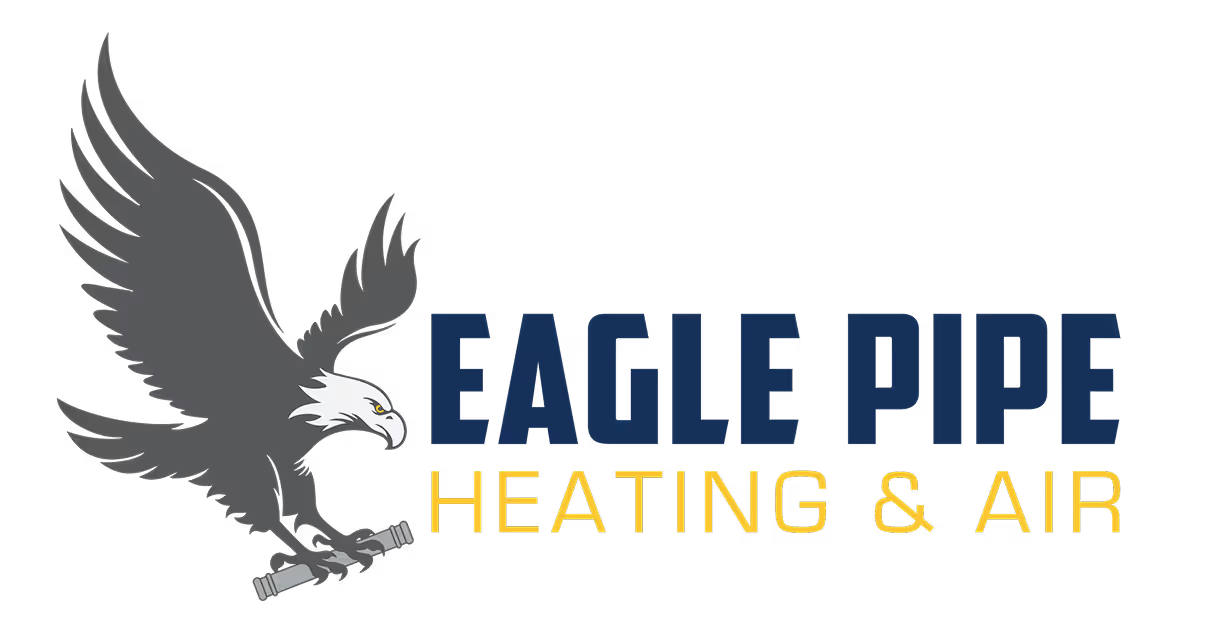Keep Your Cool: The Essential Guide to HVAC Maintenance Services

Why Your Home's Comfort Depends on HVAC Preventive Maintenance
HVAC preventive maintenance is the scheduled care of your heating, ventilation, and air conditioning systems to prevent breakdowns, optimize efficiency, and extend equipment life. Your HVAC system is the unsung hero of your home, working tirelessly until something goes wrong.
As Benjamin Franklin wisely said, "An ounce of prevention is worth a pound of cure." This is especially true for your home's heating and cooling. HVAC systems with regular maintenance can last 15 to 20 years, while neglected ones may fail in as little as 10. With replacement costs ranging from $5,000 to $10,000, preventive maintenance isn't just smart—it's essential. For every dollar spent on maintenance, you can save $4 in avoided repairs. This guide will show you how to protect your investment and keep your family comfortable.

Why Bother? The Crucial Benefits of Regular HVAC Maintenance
Your home should be your sanctuary—comfortable, healthy, and affordable. That's what HVAC preventive maintenance delivers. Think of it as giving your heating and cooling system the care it needs to take care of you.
Lower Utility Bills and Major Cost Savings
Regular HVAC preventive maintenance keeps your system running efficiently, which means it uses less energy. According to the U.S. Department of Energy, proper maintenance can reduce energy costs by up to 30%. More importantly, it helps you avoid costly emergency repairs. With a full system replacement costing between $5,000 and $10,000, the value of prevention is clear. For every dollar you spend on maintenance, you can save up to $4 in avoided breakdowns. Learn more about maximizing savings with our guide on the benefits of HVAC replacement.
Improved System Lifespan and Reliability
Your HVAC system is a major investment. Like a car, it needs regular care to last. During maintenance, technicians lubricate parts, tighten connections, and clean components to prevent wear and tear. The result? HVAC systems that receive regular maintenance typically last 15 to 20 years, while neglected systems often fail after just 10. This means proper care can nearly double your system's lifespan, ensuring reliable comfort and protecting your investment. If you're worried about your current system, see our guide on signs it's time for an HVAC replacement.
Better Indoor Air Quality and Health
The U.S. Environmental Protection Agency reports that indoor air can be two to five times more polluted than outdoor air. Your HVAC system is your first line of defense, filtering out dust, allergens, and other pollutants. HVAC preventive maintenance ensures this system works correctly. Clean filters trap more contaminants, and clean coils prevent mold and mildew growth. This leads to cleaner, healthier air for your family, which can reduce allergy symptoms and respiratory issues. Regular filter changes are key, as explained in our article on the importance of regular air filter replacement.
The Ultimate HVAC Preventive Maintenance Checklist
Caring for your HVAC system is manageable. Some tasks are simple DIY jobs, while others require a professional. Here’s a seasonal guide to keep your system in top shape.

DIY HVAC Preventive Maintenance Tasks You Can Do Today
These simple HVAC preventive maintenance steps can significantly improve your system's performance.
- Change your air filter: Check it monthly and replace it every 30-90 days. A clean filter is crucial for efficiency.
- Clear your outdoor unit: Keep at least 18 inches of space around your condenser or heat pump, free of leaves, grass, and debris.
- Keep vents and registers clear: Ensure furniture, rugs, or curtains aren't blocking airflow inside your home.
- Check thermostat batteries: Replace them annually to avoid unexpected system shutdowns.
- Visually inspect your system: Look for unusual sounds, visible damage, or leaks. Catching problems early saves money. Learn more about why your HVAC filter gets dirty faster.
Professional Spring/Summer AC Maintenance
Prepare your cooling system for summer with a spring tune-up. Our technicians will:
- Clean condenser coils for better heat transfer and efficiency.
- Check refrigerant levels and inspect for leaks to ensure proper cooling.
- Clear the condensate drain line to prevent water damage and mold.
- Perform comprehensive performance tests, including checking airflow, electrical connections, and lubricating moving parts.
Get more tips on how to prepare your AC for spring.
Professional Fall/Winter Heating Maintenance
Ensure your home stays warm all winter with a fall maintenance visit. Our service includes:
- Thoroughly inspecting your furnace or heat pump for wear and tear.
- Checking the heat exchanger for cracks or damage, which can cause dangerous carbon monoxide leaks.
- Testing all safety controls to ensure they function correctly.
- Cleaning the blower assembly for efficient airflow.
- Inspecting the ignition system, burner assembly, and flue system on gas furnaces for safe operation.
For heat pump owners, see our guide on simplifying heat pump maintenance.
Recognizing Trouble: When Your HVAC System Needs Professional Help
Even with diligent HVAC preventive maintenance, problems can arise. Knowing the warning signs can help you prevent major issues. Think of these as your HVAC system's cry for help.
Common Red Flags and What They Mean
Your HVAC system will often signal when it's struggling. Watch for these common red flags:
- Unusual Noises: Banging, clanking, or squealing can indicate loose parts, a failing motor, or a worn belt.
- Strange Odors: A musty smell may mean mold, while a burning odor could signal an electrical problem. A rotten egg smell suggests a gas leak and requires immediate professional attention.
- Weak or Uneven Airflow: This can be caused by clogged filters, leaky ducts, or a failing blower motor.
- Frequent Cycling: If your system turns on and off constantly, it could be due to a faulty thermostat, low refrigerant, or an oversized unit.
- Higher Energy Bills: A sudden spike in your utility costs often means your system is losing efficiency and working harder than it should.
- Visible Leaks or Moisture: Water pooling around your indoor unit could be a clogged drain line or a more serious refrigerant leak.
If you notice these symptoms, use our HVAC troubleshooter to learn more, and check our guide on signs of an AC refrigerant leak.
The Consequences of Neglect
Ignoring HVAC problems can lead to disastrous and expensive outcomes. A minor refrigerant leak can destroy a compressor, turning a small fix into a major expense. A clogged drain line can cause significant water damage and mold growth. For gas furnaces, a damaged heat exchanger poses a serious risk of fire or carbon monoxide poisoning.
Furthermore, neglecting maintenance can void your manufacturer's warranty, leaving you responsible for the full cost of repairs or a premature replacement, which can run from $5,000 to $10,000. Don't wait for a catastrophic failure. Learn the top reasons for HVAC replacement.
Why Bother? The Crucial Benefits of Regular HVAC Maintenance
Your home should be your sanctuary - comfortable, healthy, and affordable to maintain. That's exactly what HVAC preventive maintenance delivers. Think of it as giving your heating and cooling system the care it needs to take care of you.
Lower Utility Bills and Major Cost Savings
Regular HVAC preventive maintenance is your best defense against high utility bills. A well-maintained system runs more efficiently, and according to the U.S. Department of Energy, this can reduce your energy costs by up to 30%. The real savings, however, come from avoiding emergency repairs. A full system replacement can cost between $5,000 and $10,000. For every dollar spent on preventive maintenance, you can save up to $4 in avoided repair costs. Regular check-ups catch small issues, like a loose belt or dirty coil, before they become expensive system failures. For more on savings, see our guide on HVAC replacement services benefits.
Improved System Lifespan and Reliability
Your HVAC system is a major investment. Just like a car, it needs regular service to last. During maintenance, technicians lubricate moving parts, tighten electrical connections, and clean components to prevent wear and tear. This simple care makes a huge difference: well-maintained systems typically last 15 to 20 years, while neglected ones may only last 10. Regular maintenance nearly doubles your equipment's lifespan and prevents unexpected breakdowns, ensuring your family stays comfortable year-round. If you're concerned about your system's age, our article on signs it's time for an HVAC replacement can help.
Better Indoor Air Quality and Health
The U.S. Environmental Protection Agency warns that indoor air can be 2-5 times more polluted than outdoor air. Your HVAC system is your home's first line of defense, filtering out dust, allergens, and pollutants. HVAC preventive maintenance ensures it does its job effectively. Clean filters trap more particles, sanitized coils prevent mold growth, and sealed ductwork delivers fresh air. The result is fewer allergy symptoms and improved overall health for your family. Learn more about the importance of regular air filter replacement.
The Ultimate HVAC Preventive Maintenance Checklist
Maintaining your HVAC system is a mix of simple DIY tasks and professional service. We've organized this checklist by season to help you know what to do and when.
DIY HVAC Preventive Maintenance Tasks You Can Do Today
A few minutes of HVAC preventive maintenance can significantly improve your system's performance and longevity.
- Change air filters regularly: Check filters monthly and replace them every 1-3 months. This is the single most important task for maintaining airflow and efficiency.
- Keep the outdoor unit clear: Ensure at least 18 inches of clearance around your condenser, removing any leaves, grass, or debris.
- Ensure vents and registers are unblocked: Check that furniture, rugs, and curtains are not obstructing airflow into your rooms.
- Replace thermostat batteries: Do this annually to prevent your system from becoming unresponsive.
- Perform a visual inspection: Periodically look for leaks, damage, or listen for unusual noises. Catching issues early can prevent costly repairs. If your filter gets dirty quickly, find out why in our guide on why your HVAC filter gets dirty faster.
Professional Spring/Summer AC Maintenance
Schedule professional HVAC preventive maintenance in the spring to prepare your AC for summer. A technician will:
- Clean condenser coils to improve efficiency and lower energy bills.
- Check refrigerant levels and inspect for leaks to ensure optimal cooling performance.
- Clear the condensate drain line to prevent water damage and mold.
- Test overall performance, inspect electrical connections, and lubricate moving parts.
Learn more about how to prepare your AC for spring.
Professional Fall/Winter Heating Maintenance
Prepare your heating system for cold weather with a fall tune-up. A professional will:
- Inspect the furnace or heat pump for wear, corrosion, or potential problems.
- Check the heat exchanger for cracks, which can lead to dangerous carbon monoxide leaks.
- Test safety controls to ensure all protective systems are working correctly.
- Clean the blower assembly for efficient heat distribution.
- Inspect the ignition system, burner, and flue on gas furnaces for safe and reliable operation.
For specialized advice, see our guide to simplifying heat pump maintenance.
Recognizing Trouble: When Your HVAC System Needs Professional Help
Even with regular HVAC preventive maintenance, issues can arise. Learning to spot the warning signs can save you from expensive emergencies. Think of it as your system telling you something is wrong.
Common Red Flags and What They Mean
Your HVAC system communicates problems through various signs. Here are the red flags to watch for:
- Unusual Noises: Banging, clanking, or squealing often points to a loose part, a failing motor, or a worn belt.
- Strange Odors: A musty smell can indicate mold in the ductwork, while a burning smell may signal an electrical issue. If you smell rotten eggs, you could have a gas leak—call a professional immediately.
- Weak or Inconsistent Airflow: This could be caused by a clogged filter, leaky ducts, or a problem with the blower motor.
- System Short-Cycling: If your unit turns on and off frequently, it might be due to an oversized unit, a dirty filter, or low refrigerant.
- Higher Energy Bills: Unexplained increases in your utility costs suggest your system is losing efficiency and working harder to heat or cool your home.
- Leaking Water: Water around your indoor unit is a clear sign of a problem, often a clogged condensate drain line.
If you notice these symptoms, our HVAC troubleshooter can help. For suspected refrigerant issues, see our guide on signs of an AC refrigerant leak.
The Consequences of Neglect
Ignoring small HVAC problems can lead to catastrophic and costly failures. A minor issue like a small refrigerant leak can cause your compressor to burn out, resulting in one of the most expensive repairs. A clogged drain can lead to widespread water damage and mold. For gas furnaces, a damaged heat exchanger can create fire hazards or dangerous carbon monoxide leaks.
Neglecting your system can also void your manufacturer's warranty, leaving you to cover the full cost of repairs or an early replacement, which can be $5,000 to $10,000. Proactive maintenance is not just about comfort—it's about protecting your home, family, and finances. Learn more about when to replace your system with our guide on the top reasons for HVAC replacement.
Maximizing Your Investment: PMAs and Smart Technology
Keeping track of HVAC preventive maintenance can be a challenge. Fortunately, there are smart ways to automate the process, ensuring year-round comfort without the hassle.
Understanding Preventative Maintenance Agreements (PMAs)
A Preventative Maintenance Agreement (PMA) is like a health plan for your HVAC system. We handle the scheduling and details, so you don't have to. A typical PMA includes:
- Bi-annual visits: We perform comprehensive tune-ups in the spring for your AC and in the fall for your heating system.
- Thorough cleaning and safety checks: We clean critical components and inspect all safety controls, electrical connections, and operating pressures.
With a PMA, you'll benefit from lower energy bills, fewer breakdowns, and a longer lifespan for your equipment. PMA customers also receive discounts on repairs and priority service during peak seasons. A PMA helps you budget for maintenance, avoids surprise repair costs, and provides the documentation needed to keep your manufacturer's warranty valid. For our neighbors in the area, learn more about our AC maintenance services in Silverdale, WA.
The Role of Smart Climate Control
Modern technology makes HVAC preventive maintenance easier than ever. Smart thermostats are powerful tools for maintaining your system's health and efficiency.
These devices offer remote monitoring via smartphone apps, provide detailed energy usage reports, and send automatic filter change reminders. Advanced features like geofencing adjust the temperature when you're away, and some thermostats can even detect unusual performance patterns that may indicate a mechanical issue, alerting you to call a professional before a small problem becomes a major one. Combining smart technology with professional maintenance is the ultimate approach to managing your home's comfort.
Frequently Asked Questions about HVAC Maintenance
Homeowners often have questions about HVAC preventive maintenance. Here are answers to some of the most common ones.
How often should HVAC preventive maintenance be performed?
The standard recommendation is twice a year. Schedule a visit in the spring to prepare your air conditioner for summer and another in the fall to get your heating system ready for winter. This bi-annual schedule ensures each component is serviced before its peak season, promoting reliability and efficiency. Homes with older systems or in areas with extreme weather may benefit from more frequent checks.
What does a typical HVAC maintenance visit cost?
A standard HVAC preventive maintenance visit typically costs between $75 and $150. While this is an upfront cost, it's a wise investment. For every dollar spent on maintenance, you can save an estimated $4 in avoided repairs. Considering major component replacements can cost $2,500 or more and a full system replacement can be $5,000-$10,000, a small annual investment in maintenance is a smart financial decision that also lowers your monthly energy bills.
Can I perform all HVAC maintenance myself?
While some tasks are perfect for DIY-savvy homeowners, others should be left to professionals. You can and should change your air filters, keep your outdoor unit clear of debris, and ensure indoor vents are unblocked. However, tasks like checking refrigerant levels, inspecting electrical connections, and cleaning internal components require specialized tools and training. Attempting these yourself can be dangerous, lead to further damage, and may even void your manufacturer's warranty. The best approach is a partnership: handle the simple tasks yourself and trust a certified technician for the technical work.
Conclusion
HVAC preventive maintenance is one of the smartest investments you can make in your home. For a small annual cost, you can save thousands in potential repairs, extend the life of your equipment, lower your energy bills, and improve your family's health and comfort.
The choice is simple: be proactive with regular maintenance or react to an expensive, inconvenient breakdown. We've seen both scenarios, and proactive homeowners are always happier.
At Eagle Pipe Mechanical, we are committed to helping our neighbors in Kitsap and Jefferson Counties maintain comfortable and efficient homes. Our team provides knowledgeable, honest, and reliable service, treating your home as if it were our own.
Don't leave your comfort to chance. Take control of your home's climate system today. Contact us for expert HVAC services and enjoy the peace of mind that comes with a well-maintained system.
CUSTOMER TESTIMONIALS
Our customers’ experiences say more than we ever could. See how Eagle Pipe Heating & Air has earned trust across the Pacific Northwest with reliable service and lasting results.





